Ultimate Guide to Exercises for Lumbar Herniated Disc Relief 2
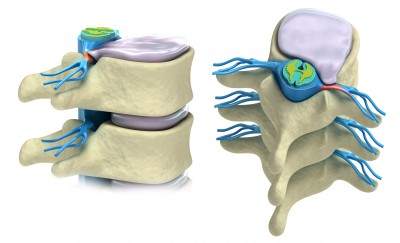
Did you find our previous article, “Disc Herniation Part 1,” helpful but are still battling discomfort? Are you eager to discover exercises that can effectively reposition your herniated disc and enhance your well-being? You’re in the right place.
In this comprehensive guide, we’ll cover:
- Effective Exercises for Repositioning a Herniated Disc: Learn the top movements to gently coax your disc back into alignment, reducing pain and improving mobility.
- Stabilization Techniques to Prevent Disc Displacement: Discover exercises that strengthen your core and back, ensuring your discs stay in place.
Understanding Lumbar Disc Herniation:
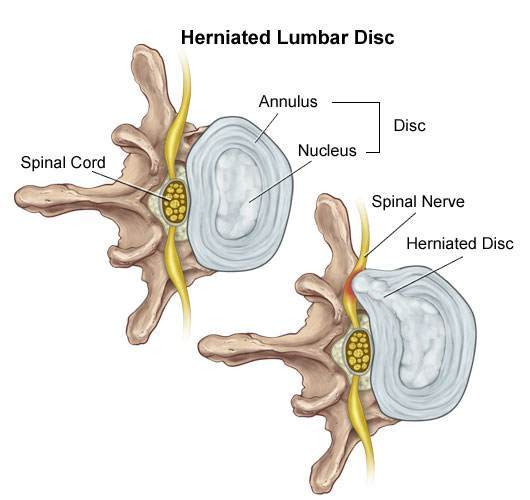
A herniated disc occurs when the disc’s nucleus breaks through the annulus, as shown in the illustration from neurosciences.beaumont.edu. But what triggers this displacement? The primary culprit is forward bending, which compresses the disc (think of it as a jelly-filled doughnut) and can lead to the annulus fracturing, allowing the nucleus to protrude and press against nerves.
Why Does it Hurt?
The disc’s exterior is tough cartilage, while its interior is softer, akin to mucus. Applying pressure on one side forces the inner material to the opposite side, similar to squeezing a doughnut. When a herniated disc or inflammation puts pressure on a nerve, pain ensues. The key to relief is applying counterpressure to reposition the disc.
For a deeper dive into herniated discs, refer to “Disc Herniation Part 1: Best Self-Treatments for Lumbar Disc Herniation.“
How to Apply Counterpressure:
The strategy involves bending your spine backwards or into the extension to shift the disc away from the nerve.
Exercises to Reposition a Herniated Disc: Note of Caution:
Initially, these exercises might intensify your pain slightly. If pain significantly worsens or radiates further down your leg during these exercises, cease immediately and consult a professional.
Exercises for Lumbar Herniated Disc
#1 Prone Lying Lumbar Herniated Disc
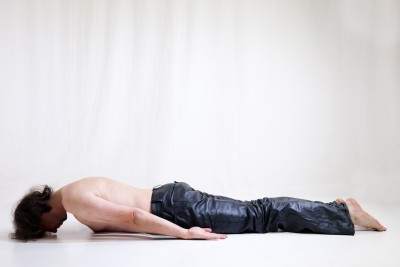
- Lie face down or prone in bed with your elbows tucked in under your side:
- As soon as you get up in the morning you should lie prone (face down). By getting in this position, your lower back becomes more arched, or as doctors say, you increase your lordosis.
- The increased lordosis pushes on the back of the disc helping to bring the nucleus forward into the correct position.
#2 Sphinx pose in Yoga For Lumbar Herniated Disc
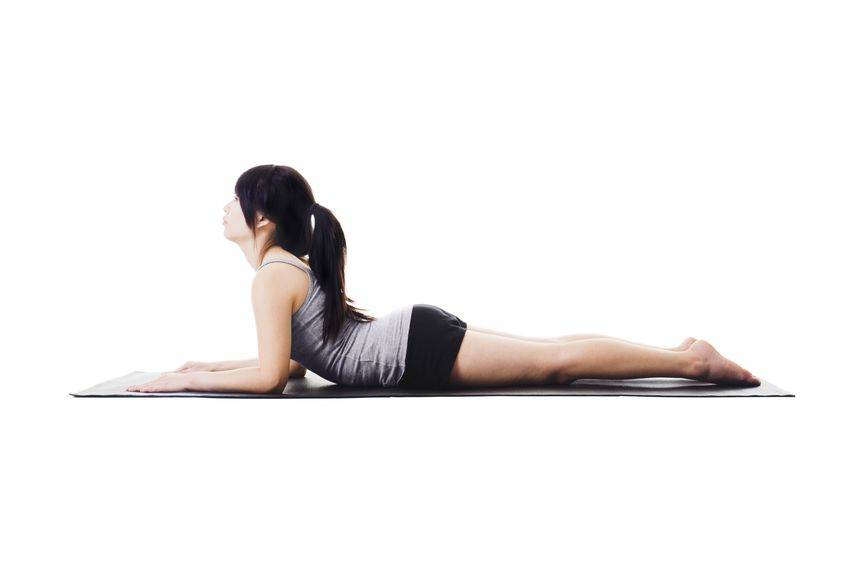
- Get into the prone position lying down on your stomach.
- Next, get on your elbows. If you have a hard time with this position go back into the prone lying position.
- Do these exercises hold each time for 1-2 seconds 6-8 times per set? This exercise can be repeated every two hours throughout the day.
Asses yourself. If the pain has decreased or the pain has moved away from the leg or thigh and into the hip or buttock, this is an improvement. Even if the pain is increased in the back but relieved in the leg this is an improvement and a green light that you should continue this exercise. You also get a green light if there is no difference at all.
- If your self-assessment gives you the green light, move on to the Cobra exercises just below.
- If your thigh or leg pain is worse, then stop right away.
- If your lower back, thighs and legs are the same you get a green light, so move on to the Cobra exercises.
#3 Cobras For Lumbar Herniated Disc
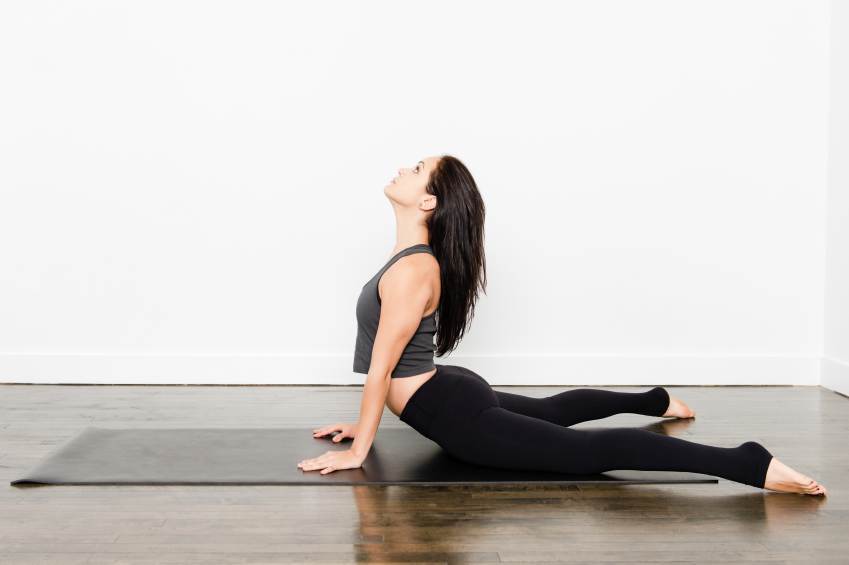
- Lie down face down with your hands underneath your shoulders.
- Push up from as high as you can until your lower back stops you or your elbows are straight.
- The pelvis should still be on the floor and the lower back muscles relaxed.
- Do these exercises hold each time for 1-2 seconds 6-8 times per set? This exercise can be repeated every two hours throughout the day.
Asses yourself. If the pain has decreased or the pain has moved away from the leg or thigh and into the hip or buttock, this is an improvement. Even if the pain is increased in the back but relieved in the leg this is an improvement and a green light that you should continue this exercise. If your thigh or leg pain is worse, then stop right away.
#4 Standing Extensions Lumbar Herniated Disc
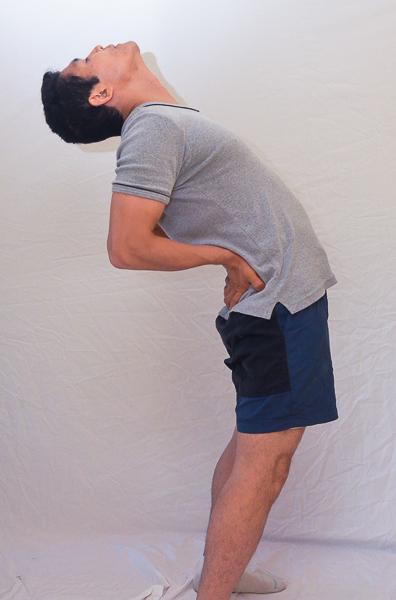
- Stand straight and put your hands behind your hips with your fingers facing down.
- Push your hands into your pelvis so that your lower back arches.
- Don’t use your lower back muscles
- These exercises can be done 6-8 times for 1-2 seconds. This exercise can be repeated every two hours throughout the day.
Stabilization Exercises: Prevent Your Disc From Coming Out By Having A Stable Spine.
#1 Cat-Camel or Cat-Camel For Herniated Disc
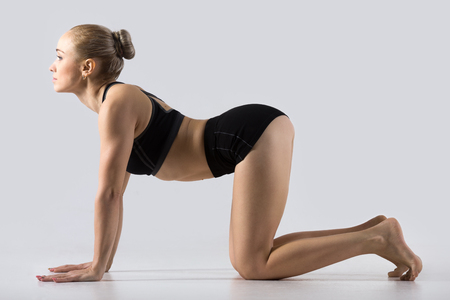
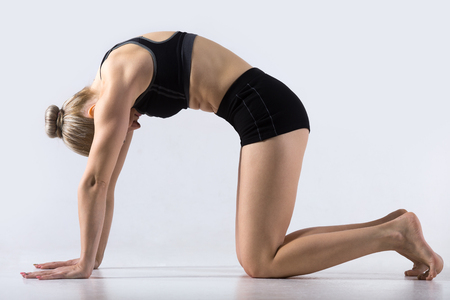
- On all fours with your knees under your hips and hands under your shoulders.
- Inhale and let your belly fall downwards toward the floor as you look up toward the ceiling for 2 seconds.
- Exhale and arch your back up as far as it will go or until you feel pain. You should not feel pain with this exercise, otherwise you are going too high.
- At the same time bend your neck forward and look toward your navel.
#2 Curl-Ups
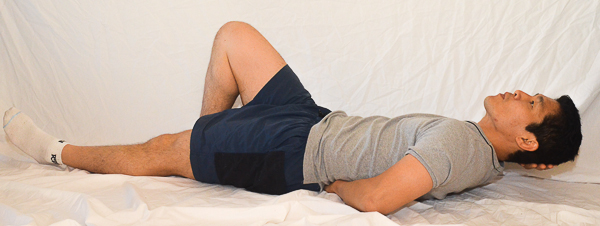
- To start, one foot is bent and the other is straight.
- One forearm goes under the arch of your lower back to support it.
- The other arm is supporting your head.
- Your head and neck come up as one block until your shoulder blades clear the floor.
- Do three sets of 5 working your way up to 10. If it’s easy, then hold for a couple of breaths.
#3 Squats
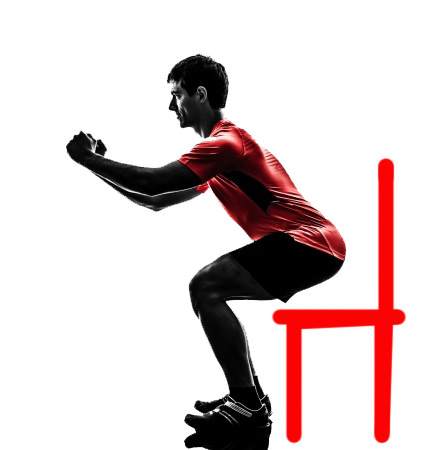
- Stand in front of a chair as if you are going to sit on it.
- Stand with your feet facing slightly more outward than your knee.
- Make sure your butt comes out, and keep lowering your butt until you touch the chair.
- Practice 3 sets of 10.
#4 Bird Dog
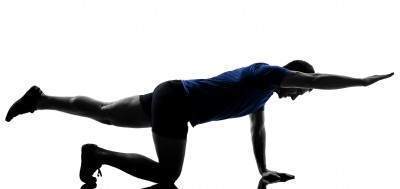
- Get into a crawling position with your hands and feet shoulder-width apart.
- Harden your core by contracting your abs and lower back. This is called bracing.
- Lift your arm first. If this is easy, then lift your leg only. If that is easy, then lift the opposite legs and arms, for example, right leg, and left arm.
- Want to make it tougher? Try lifting an arm and leg on the same side.
- 3 sets of 10. If you are shaking a little or cannot balance quite right, you’re doing the right exercise for you, i.e. lifting just the leg or arm might be easy, but lifting opposite arms and legs might put you off-balance a bit. Make sure you are stable before going to the advanced bird dog.
Tell us what you think in the comments below and like us on Facebook. This Toronto Downtown Chiropractor will answer all questions in the comments section. Let us know your vote for the best Toronto chiropractor in the comments section.
References
1. J Med Genet 2002;39:387-390 doi:10.1136/jmg.39.6.387


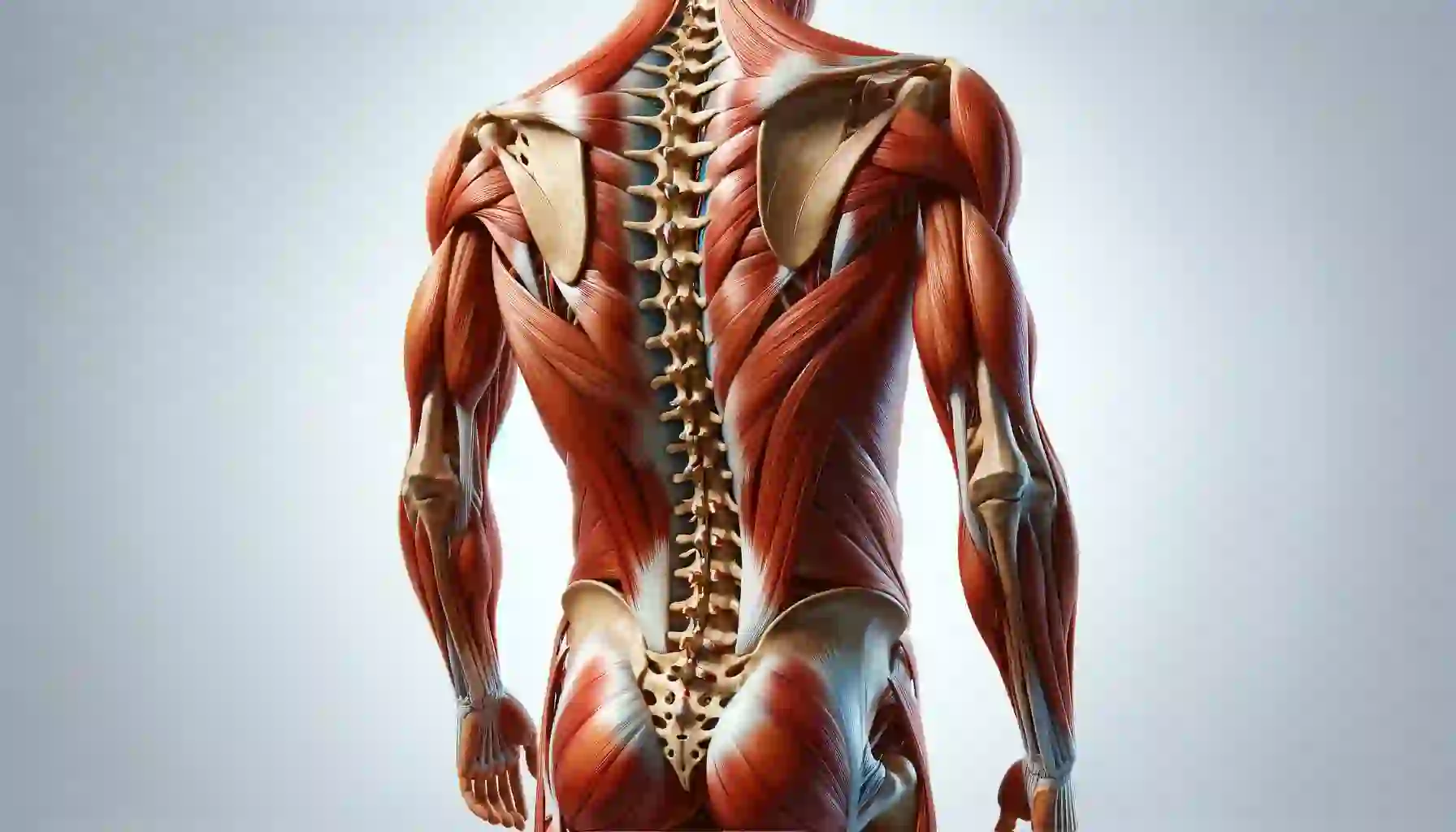
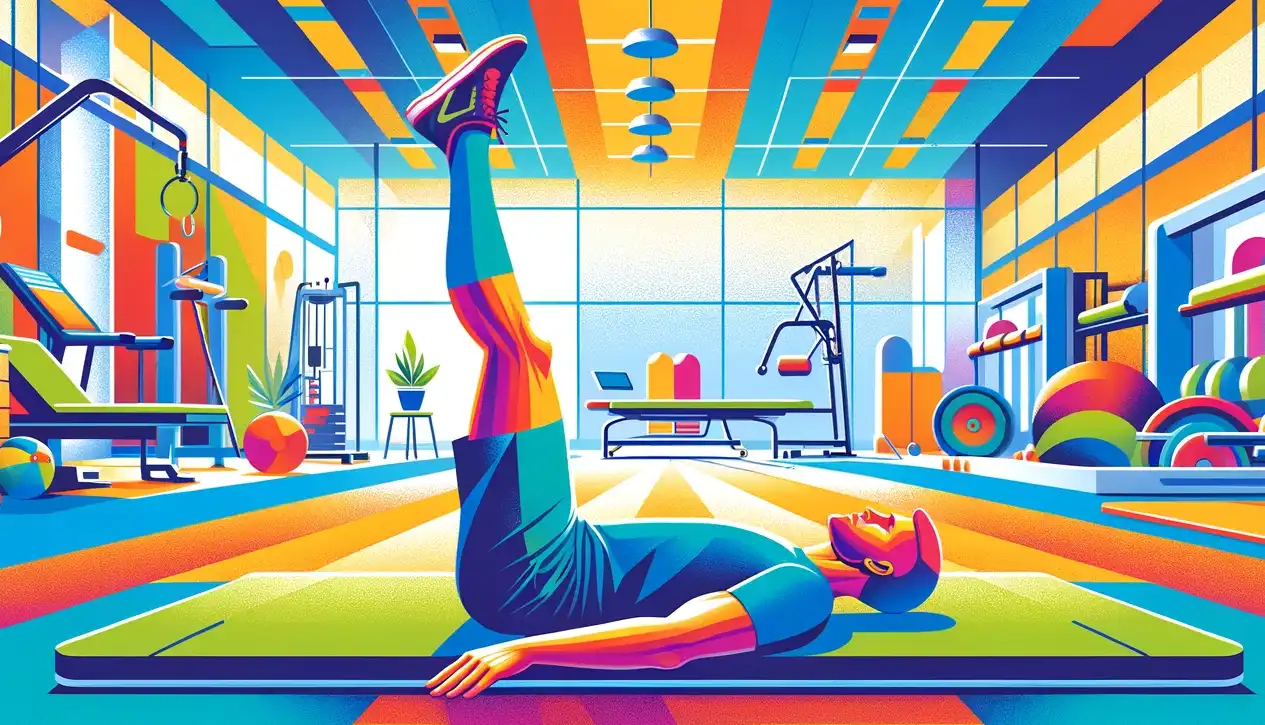
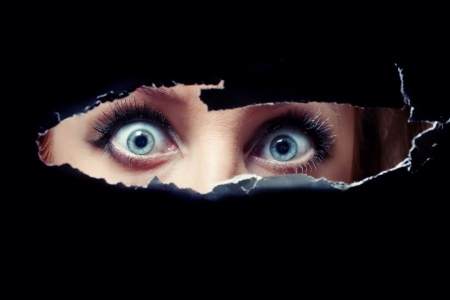
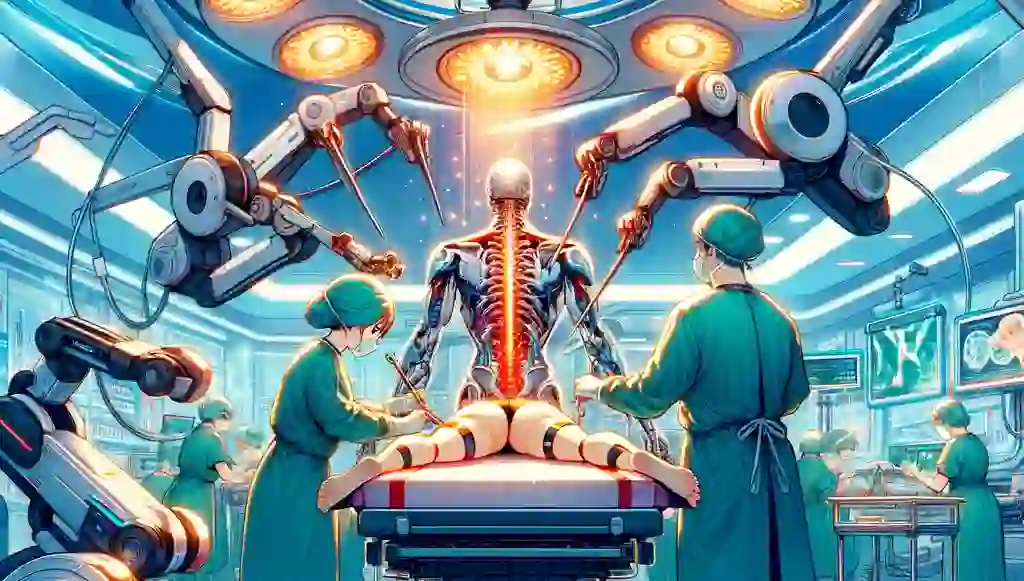
Hello Dr Nakamura and thank you for your guide.I am 25 and had a lower back pain a year ago and the pain was awful for few weeks and i had a huge relief while going for swimming for about a week.The thing is although the pain went away i feel my back is not 100% cured.Sometimes i have little pain espectially when getting up from bed or bending forward but it nothing like before though.So yesterday i went to gym and did some deadlifts not much weight (trying to be careful) but after some reps i felt the back pain coming.When i lay down on bed i can raise both my legs and have no pain but when i sit on a char and have a 90degree angle i have a lower back pain(a bit on the right side) when i try to raise my right leg. I didnt see any doctor i thought the time will heal my back completely but it didnt. Its over a year now and am started to worry , can you tell me if this can be treated completely while doing your exercises or what to do really? Thank you doctor
Author
Thanks for your question Christofer Z. You should take up swimming again as well as doing the exercises here in this article. You should also see someone in your area if you are really worried about your back as I cannot examine you. To answer your question, some people can be treated by exercises alone but others require treatment. Generally the more complicated and more long standing the problem the more likely you will need to be treated by someone.
Hope that helps your lower back pain.
Thanks!!
Author
You are welcome Pauline.
Dr. ken, I just saw your post previous to mine about flat feet, the IT band, and tronchater inflammation. This sounds very similar to what I described in my initial post especially since I rolled my ankle and lost some of my arch.
I couple questions…with what I initially described, do my symptoms sound like a disc issue or more of abnormal gait/IT band issue?
What can I do to regain the arch in my foot? Orthopedics?
Author
Thanks for your question Will. Yes orhotics will likely help.
Hope that helps.
Hello Dr Ken. About four months ago I began experiencing a very mild tingling sensation in my outer right thigh. It would only be brought on after standing for long periods of time. I continued to play basketball and lift weights. At no point have I ever had any back pain or tightness. The issue has now become a very mild burning sensation in my outer hip area. I have also been experiencing muscle twitching in my thighs that seems concentrated on the outside and upper portion of my thighs. I cannot produce the pain with any movement. I can go into full extension and full flexion without any pain what so ever. The only other thing I have noticed is a very dull ache on my si joint after running.
I did roll my ankle badly last year so I was hoping this was the result of abnormal gait. I have had 2 x Rays of my hips and lumbar spine which shoewed healthy pelvis and spine. Dr. ken, does this sound like it could be a lumbar disc issue even though I cannot produce pain with any movement? It has just been intermittent aching and twitching in both thighs and dull intermittent burning in outer hips.
Thanks.
Author
Thanks for your question Will. Likely orthotics would help in your case by giving your foot the arch support it needs. This will take the pressure off your hips. It’s normal to have have X-rays that are normal as soft tissue shows up very poorly on X-ray.
Hope that helps.
Thank you Dr Ken.
The only symptom I have the bother me is outer thigh twitching on both sides and sometimes a sensation of tightness in my shin just below my knee. Sometimes the twitching is pretty often. I have been foam rolling my IT band a lot and that seems to help. Does this sound like a serious herniation affecting the lateral femoral nerve or would symptoms be more severe if I had a severe herniation?
In the event I actually had a herniation, I am guessing it would be around l2-l3 since my symptoms seems to be in areas affected by the lateral femoral cutaneous nerve. Again, I cannot produce pain with full flexion or extension. I have felt slight tightness with twisting motions but this is only so slight I wonder if I am making it up. Will these exercises help me or do you recommend something others?
Author
Thanks for your question Will. First it doesn’t sound serious and it doesn’t sound like a disc herniation. You should simply get orthotics like I said in the previous post. I think you have done great research for what ails you but that is part of the problem. I think you are associating symptoms that you have and trying to find what fits on the web. The problem is many other things will fit including a disc herniation but only partially. Your problem doesn’t sound like a disc herniation. You said your flexion or extension has no effect on your spine. That is why it is not likely coming from the spine.
I haven’t examined you so that is all I can give you. If you really want to know more, than you have to have someone examine you. I am only giving you an opinion for educational purposes. Without an exam, it’s just an opinion.
Hope that helps your hips.
Last question please, being doing the plank, but now getting what I believe to be Greater Trochanteric pain at night, can the plank cause this or is some other factor more likely? Thanks
Author
Thanks for your question Pauline. The plank won’t cause this. It is usually due to walking a lot with flat feet, excess cycling, eliptical, treadmill or a tight glut medius along with TFL (tensor fascia lata muscle). The TFL attaches to the ITB (IlioTibial band) which goes right over the trochanter bursa making it inflammed. Again though it is usually due to a flat foot or subtalor pronation. (basically the foot flattens while walking)
Basically I said the same thing in many different ways. Flat feet will tighten the IT Band (IlioTibial band) rubbing against it causing the TFL and glut medius to tighten. It can be aggravated but not caused by the above exercises.
Hope that helps with your greater trochanter pain.
Hello Dr. Nakamura,
about 7 weeks ago I did some jumping exercises and two days later I had pain in my foot. This is how it started. I then slept on a too soft mattress (which I no longer have) and did some yoga exercises that involve flexion (toe touches, etc). I didn’t know at that time that this can cause a herniated disc. My lower back got much worse after a couple of days with the peak of the pain around 3 weeks ago. In my case, it is really bad every morning after getting out of bed. It then takes me around 2 hours to walk it off. In the afternoons I hardly have any disc pain at all as long as I don’t sit. If I sit down (even if only for 5-10 minutes), the pain starts. Why does sleeping (bed rest) make it so much worse? My disc injury is on my low right, so I sleep on my left side and back.
Author
Thanks for your question Sandra. Sorry to hear you are in pain. Sounds terrible. The pain is worse in the morning due to the disc. When you sleep you are lying down and not putting any pressure on the disc or very little pressure. This allows the disc to absorb fluid (scientists call it imbibe) When you absorb more fluid you increase the pressure in the disc. Since you are lying down you don’t feel any more of that increased pressure.
However when you sit or stand in the morning you increase the pressure on the disc even more. This additional pressure combined with the larger disc puts pressure on the nerve in that comes out from between the vertebrae. This nerve is called the spinal nerve. The spinal nerve essentially gets squeezed by the disc.
The key is to lie face down in the morning to decrease the pressure from the disc for a few minutes. Then do the extension in lying exercises or the Cobra. Just don’t do the exercise the way it’s done in Yoga; do it the way I describe it. Doing it the Yoga way may help but is much less likely to help.
You should expect some soreness initially when doing the Cobra. This is normal. As you progress if the pain increases or starts going further into the buttock or leg than you should stop.
Hope that helps your disc herniation.
Hello again Dr. Nakamura,
I appreciate your reply! Yes, that makes sense that the discs collect fluid overnight and expand and that this could cause pain for me every morning. I tried doing the McKenzie stretch while still in bed, but I find this very hard. All I can do is lie on my stomach. When I get up every morning, I have a hard time walking straight. I walk in a slightly hunched position for 1-2 hours until I can fully straighten my spine. If I go back to bed to lie on my stomach this is very difficult too (even more difficult after having been up for a while compared to before getting up, but it’s only difficult in the mornings). The McKenzie stretches are easy during the rest of the day. Is this common with disc bulges/herniations? Also, yesterday I iced it for 15 minutes, which made it worse. I got spasms in my buttocks after doing that and it was more painful overall. At this point I’m not even sure if I have a bulge or a herniation. Is there any sure way how to tell without having an MRI done? Thanks again!
Author
Thanks for your question Sandra.In your case you should lie on your stomach then if you are able go to the sphinx position. If not that is OK. As for if you have a bulge or herniation, it really won’t change the treatment so it won’t matter unless you were a getting surgery.
Hope that helps your disc herniation.
Hello Doctor,
I’ve had sciatica for approx. 7 months now. The Pain is not really intense, but more of an ache in my left buttock that also appears at the back of my right calf. The worst pain is trying to put on my socks in the morning,it aggravates the pain in my buttock. I’m a very keen road cyclist and the pain doesn’t appear when I’m cycling.
I’ve had an MRI scan and these are the results:
The lumbar lordosis is straightened.
From L3 to S1 there are degenerative changes with height loss and dehydration of the discs.
At L4/5 there is moderate sized right sided disc extrusion which indents the thecal sac and compresses the right L5 nerve root.
The conus terminates at L1 and is normal.
Please tell me what execises would benefit me the best and maybe get rid of the sciatica in my left buttock and calf . Will the cycling make things worse? I do not have any sciatic pain whilst cycling, but do get back ache after a long intense ride.
Looking forward to your comments, Simon
Author
Thanks for your question Simon. First when cycling you should sit up right with an arch in your back. Continuing to ride especially in the arrow position will make the disc stick out more and eventually cause more sciatica. Your problem is an extrusion which is almost as bad as it can get. It can get to a sequestration which is the worst stage. Having said that the disc can stick out more and more with flexed cycling.
If you don’t change the way you cycle you will not get better. The problem didn’t start 7 months ago it started many years before that. Combined with a weak disc you now have a disc extrusion.
Try the exercises here in this article. You should do standing extension before and after cycling. Right now if you try to do cycling your spine will be flexed even if you sit upright as you have forced it into that position. Take a week to two weeks to increase the extension using the cobra (not the Yoga Cobra) but the extension exercises in this article standing extension and lying extension (yes I do call it Cobra but that may have been a mistake).
Hope that helps your disc extrusion.
Hello again Dr. Nakamura,
Thank you very much for your valued comments.One more thing, in your opinion should I totally give up cycling, as I do not want it to compromise my health,or can the disc extrusion be managed with the exercises above and therefore let me continue doing the only exercise I truly love.
Again many thanks,
Simon
Author
If you change the way you cycle you can continue on cycling in the future.
Hope that helps Simon.
Just a quick question is it ok to do the front plank with a sliped disc at L5/S1 it doesn’t cause pain when doing it? Plus does the front plank work all the core muscle? Trying to work all the core muscle but so difficult with a slipped disc.
Author
Thanks for your question Pauline. The front plank is fine but the side plank may aggravate things. The idea is not to have a strong core at the expense of getting you better and giving you more pain. Only some core exercises are safe to do. Sit-ups and leg raises can cause problems.
Hope that answers your questions about core exercises and slipped discs.
Dr. Nakamura,
Around the beginning of December a tingling numbness crept down my right leg while I was sitting. After a few days it persisted so I tried going to my chiropractor he adjusted my pelvis because i was 1/2 in shorter on one side. A day after that the numbness got much worse so i scheduled an apt with my doctor. 3 days later at my doctors apt. he sent me to the ER for an mri because I was also experiencing numbness in my genitals.
Since then the numbness has thankfully left my genital area. It has however started in my left foot and sometimes calf. Through walking allot and doing recomended stretches I have achieved near full sensation on multiple occasions usually in the evening. It almost always returns in the morning, sometimes less sometimes more.
According to my MRI
There is a small benign bone hemangioma on the s3 vertabral body,
At the L5-S1 the disc is moderately narrowed,
there is a posterior central disc protrusion which is minmally extruded caudally
this is not impending on dural sac or nerve roots
ther may be some minimal facet joint hypertrophy of the bilateral L5-S1
indicating earlyosteoarthritus change
There is a 5mm cyst in the rightneural foramen and the L5-S1,
probably an incidental nerve root sleeve cyst
There are findings of degenerative disc disease and degenerative facet joint disease at L5-S1,
There is no apperrent spinal stenosis or neural impingment.
So that is as much as I know, I was just curious what your opinion or recomendations might be.
Thx Ash
Author
Thanks for your question Ashley. First it’s great that you have gotten better. The combination of L5S1 disc narrowing, disc protrusion, hypertrophy or enlargement of the facet at L5-S1 and possible cyst will cause likely cause symptoms of a disc herniation. In the morning your discs are larger as they absorb fluid. So when you sit and stand in the morning you put more pressure on the disc than compared to the night.
So the MRI will show a small disc with not much pressure on the nerve. This is not true situation as you are lying down in the MRI. If you had an MRI while sitting it will show much more pressure on the nerve.
Also if you continue to have pain I would keep an eye on the “cyst” to see if it is growing. Whether benign or not if it is growing than it will put pressure on the nerve.
I would continue the exercises that made you better and add the exercises here in this article. If you get pain further down the leg or the pain becomes more intense than the exercises here are not for you.
Hope that helps your disc herniation.
Thanks, no I will support the back with my hand so it doesn’t move when I contract my stomach muscles, have been trying to get this question answered for a long time, so glad I found this site!
Author
You are welcome Pauline. Glad to have helped.
if I put my hand behine my back to keep the arch when lieing on the floor can I still tense my stomach muscle quite strong? or would this squash the discs? It’s just I really like this exercise Thanks again!
Sorry forgot to say but not tilting pelvis.
Author
Thanks for your question Pauline. If you are not tilting your pelvis this shouldn’t bother your discs unless they are very acute.
Hope that helps your herniated disc.
Hi have been advised to build up core muscles to help with lower back pain, however when I do a pelvic tilt I really push my back in the floor and tense my stomach muscle as much as I can which is giving me really nice strong muscles, but lately getting buzzing in foot and worrying if doing this exercise and really tensing stomach to the max can cause a bulging disc? Thanks
Author
Thanks for your question Pualine. For most people but not all people with a disc herniation pelvic tilts make their disc herniation worse. I recommend against it. You likely have a disc herniation that is posterior, meaning the disc is sticking out the back. The pelvic tilt is like bending forward which will make your disc push out more. It’s basically like pushing on the front of the doughnut which makes the jelly come out the back.
Hope that helps your understanding of disc herniations and why you shouldn’t do pelvic tilt with your type of disc herniation.
Hi Dr!
You’re site is brilliant, thank you.
I would greatly appreciate any thoughts on my situation.
I had period of severe lower back pain 12 months ago that recovered within 2 weeks.
In October i developed a pain in my right buttock, mostly while sitting, that I assumed was muscular. It slowly worsened and over Christmas I developed sciatic pain. It was manageable until 10 days at which point it became absolutely excruciating.
I went to my GP that day who gave me a clinical diagnosis of a prolapsed L5S1 based on the straight leg test, an absent right ankle reflex and inability to bear weight on my right leg. i was prescribed difene and a muscle relaxant. I haven’t had an MRI. I’m due my first physio appointment next week.
I have had a slight improvement in the past ten days and can now walk about 15 paces before the sciatic pain kicks in. Unfortunately it then becomes too paiinful to walk then and i need to lie down for relief.
I guess I worry that I’m not mobilising enough as I know too much rest is counter productive. I have tried some of your gentle extension exercises and think they are helping a little with the lower leg pain.
I look forward to hearing from you and thanks again for all the information you provide on the site.
G Kelly
Author
Thanks for your question G. Kelly. Assuming you have a herniated disc, which it appears to be, you should try doing the exercises in this article. Your disc took years to develop this way in fact for most people it starts when you are about 20 years old. That is when the arteries that feed the disc from the vertebrae disappear. They simply disappear as we are not designed that well as we would like. This starts a process of degeneration which leads to the annulus (outer part of the disc) weakening. When the annulus weakens enough the inner part of the disc called the nucleus comes out. So what you felt a year ago was likely when when one of the annular layers tore. Most of had already torn before you simply didn’t feel it. You can’t feel as only the outer third of the annulus has nerves.
In October you probably bent forward to pickup something or put on your shoe or sock and tore another bit of your annulus. Now there is a full blown extrusion or protrusion that will likely be seen or MRI.
Try the exercises first. If the exercises increase the pain or make the pain or any other symptom go further down the leg, then you should not do the exercises.
Hope that helps your disc herniation.
Thanks for replying.
I saw my physio since my last post who has prescribed the very same exercises as you have detailed here! Hopefully this will help.
Thanks again.
G. Kelly
Author
You are welcome G Kelly.
Couldn’t sleep last night because of my lower back pain so I grabbed my phone and found your website. I just tried the exercises and my back already feels better. Thnks for the tips, I will be doing these more often. Thank you!
Author
Thanks for your comment. I am very happy the exercises helped.
Dr. Nakamura can you please answer me. Your opinion is important for me. Also i found discus compositum n injection, they are homeopatic, think they can help?
Author
Thanks for your question. Your other question is now answered. As for discus compositum, I can only say that homeopathic that I have used to date have not worked for me. Perhaps they were of the wrong type or dose. The research does not support them but doesn’t mean it doesn’t work. Many randomized controlled trails are flawed as they do not categorize patients properly so almost nothing works for low back pain according to the research. Only manipulation and rehab exercises seem to work.
Hope that helps your herniated disc.
Hello, Mr. Nakamura. I wanna first tnx you for supporting all of us and this great site! Let me describe my problem. I have disc prolapsed l5s1 after dead lift with 320lbs (around 146kg) around may 2013. After this i dont know for my problem also i dont have pain in legs only small constrain in right low back. After two week everything gone. Last year, may 2014 on my right leg i feel shooting pain along of the nerve. After visit to doctor they make me Computer Thomography with diagnose: “Normal L3-4 and L4-5. L5-S1 right side medial lateral disc prolapse asymmetric narrowing the spinal canal.” Ok, sorry for my bad ebglish, its not my main language. After this i was thread with exercises, ultrasound around unhealth disc, magnet ring for 15 min. Pain in low back and leg gone, but my work is on desk, i am programmer. Around 2 month pain start only in low back in sit position. I think is chronic, because everyday i feel it. I keep do exercises now use (Modifide Watkins – Randall protocol), try to be more mobile. What can i do to overcome this problem. I am 220lbs (100kg), if reduce to 198lbs (90kg) or more do you think pain will be less. Mr. Nakamura, like you, i also love my work and dont wanna change it. I think for surgery, but all doctors said its not good idea.
Author
Thanks for your question Morales. While stabilization exercises are helpful they only helpful stabilize (modified watkins-randall). They do nothing to help put the disc back into place. For mild disc problems it may be enough. When the disc is too far out no matter how many stabilization exercises you do it won’t help. You need to do the exercises here in this article.
Hope that helps your disc herniation.
Thank you, Dr. Nakamura for answer. Today i start your recommended execsises. Have a nice and keep help, your gold for patients with pain.
Author
You are welcome Morales. Good luck with your herniated disc.
Dr. Ken,
thanks for the reply. So if I am doing the chins tucks and neck extensions (protruded/extruded cervical disk) , more tingling and numbness means it is getting better? Just going by what the article said unless I misread it.
Thanks,
Driz
Author
Thanks for the question Driz. If you are getting more tingling and numbness you are getting worse. Try just doing the chin tucks. If the chin tucks do the same then you need professional help.
Hope that helps your cervical disc herniation.
Hello doctor -what an excellent & informative website!
I’ve been suffering from lower back pain for past one year. Had about four episodes of back pain in last one year (starting in December’13). Each time I’ve been prescribed with some muscle relaxant and physiotherapy. Noticed recovery time is increased with each episode. Whenever This happens, I get acute pain in lower back (but no pain in legs!).and I can’t stand straight or walk for initial day or two.
First MRI was taken in April 2014 and reads as below:
DEGENERATIVE lumbar spine changes with lumbar canal stenosis from L2 downwards.
Aggravation of canal stenosis at L3-4 and L4-5 level due to disc protrusion arms ligamenta flava thickening causing significant thecal sac compression more marked at L4-5 level.
second MRI was taken in January 2015 and reads as below:
Diffuse disc bilges from L2/3 to L4/5 levels compressing the Thecal sac and contained nerve roots with focal Thecal sac stenosis at L4/5 level. Bony canal appears narrow.
I’m told to be heading for a surgery. Although I’ve few opinions suggesting to continue with exercises and physiotherapy. Personally, I would like to avoid surgery. Please can you help suggest if I should continue with surgery or physiotherapy? It would be very helpful if you could suggest what type of back exercises would help me most for recovery?
Can’t thank you enough… awaiting your reply.
-Mohit.
Author
Thanks for your question Mohit. Really the question in your case is whether your pain is coming from the stensosis or the disc herniation or both. In your case the stenosis was there from birth and the discs which are weak are aggravating the problem. I would try two different set of exercises to see what helps. You want to determine if stensois is the main cause or the disc herniations.
The disc herniation exercises are in this article and the stenosis articles are here: https://www.bodiempowerment.com/spinal-stenosis-comprehensive-guide-5-exercises-spinal-stenosis-lateral-stenosis/
Likely it would be the stensosis but I haven’t examined you. You will know which set of exercises are for you by how you feel. If you get more pain while doing the exercises or increased numbness or tingling further down into the buttock or thigh then you are getting worse. Then you do the other set of exercises.
Hope that helps your stensois and disc herniation.
Thanks very much Ken. Really appreciate your response! I would surely give both set of exercises a go.
Even I’m confused as to origin of the pain is stenosis or disc bulge at L4/5.
Not sure if relevant and useful in determining this cause, but there is an additional finding in both MRI which I missed to mention earlier:
” Straightening of lumbar spine is seen with loss of normal lumbar lordosis. ”
Both MRI WERE taken whilst I was in middle of a painful episode.
Is stenosis curable through exercises? Will I be able to avoid the surgery?
Again many thanks for your patience and all answers.
Mohit.
Author
Thanks for your question Mohit. Your stenosis looks like you were born with it so it is not curable. Having said that I have treated many people with stenosis before and they do get better without surgery. Usually it takes a lot longer. The MRI results you have just given me doesn’t change what I think about your condition.
Hope that helps your herniated disc and stenosis.
Hi Doc,
great website,
I was doing some heavy dumbell lat rows while on an incline bench. My forehead was pressed against the bench and on my first set I felt a crunch in my neck. Like an idiot I did two more sets. It was a bit stiff but the icing on the cake did not happen until the following day. I was trying to get into a small car and cranked my neck again. After I sat upright my neck was killing me and my arm got some numbness. I tried to do a bench press the next day and my left tricep was noticably weaker than the right. This was 3 weeks ago. The neck stiffness has gotten a lot better, but the top third of my index finger is numb along with remaining tricep weakness. When I sit up straight for a while I get more numbness and stiffness, but when I ssit back or recline I feel better. Looking up sometime hurts my neck. Chin tucks don’t hurt at all. Based on my research I think I have either a herniated disk at the c5-c6 level or a bulging disk. I have been to the chiro only twice as I am trying to rehab on my own. My chiro I saw today thinks it’s a bulging disk. Based on my symptoms what do you think? I have not had an EMG, CT, or MRI yet.
Thanks for your time
Author
Thanks for your question Driz. Why don’t you read this article. To most people even among many professionals a bulging disc and herniated disks are used interchangeably. Technically they are not the same but many chiropractors and physiotherapists use one term for another. Having said that the stages are bulging disc, protruded disc, extruded disc and finally sequestered disc.(sequestered disc is most severe) They are all herniated discs.
On a personal level you can have a bulging disc that gives you numbness to the fingers but more likely you have an protruded or extruded disc. Try reading this article for cervical disc herniations.
https://www.bodiempowerment.com/cervical-disc-herniation-best-exercises-help-sore-neck/
Hope that helps your herniated cervical disc.
I am an 18 yo senior in high school with a scholarship to kick and punt in college, I was originally diagnosed with herniated disc in 2011, quit playing a position and just kick and punt. I will try the exercises but am in considerable pain in the leg and lower back. My big thing is, should I continue to play football in college, or just concentrate on staying in shape?
At L4-5, there is desiccation and diffuse bulging extending into both foramina. There is moderate central
canal stenosis, mild to moderate bilateral foraminal stenosis. Facet hypertrophy is mild in degree.
At L5-S 1, there is a sizable central herniation. This effaces ventral epidural fat and the ventral thecal
sac. It measures approximately 8 mm in AP dimension and 1.9 cm in transverse dimension. There is
moderate canal stenosis with posterior displacement of the thecal sac. It extends into the proximal
aspect of each neural foramen where there is mild to moderate stenosis. There is mild facet
hypertrophy.
Impression:
1. Straightening.
2. Bulging L4-5.
3. Sizable central herniation L5-S 1.
Author
Thanks for your question H Mack. The main thing is your large central herniation at L5S1. You should try the exercises first. If the exercises give you increased pain or symptoms that go further down the leg including numbness, tingling or pin & needles than the exercises are not for you.
Hope that helps your herniated disc.